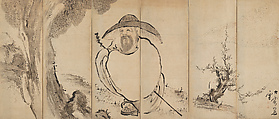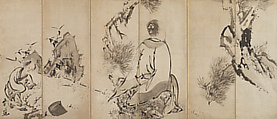Returned to lender The Met accepts temporary loans of art both for short-term exhibitions and for long-term display in its galleries.
Meng Jia Loses His Hat (left); The Chinese Poet Su Shi (right)
Ike no Taiga Japanese
Not on view
Taiga is considered the preeminent eighteenth-century Japanese literati artist. Here, in a spirit of admiration and empathy for the ancient Chinese literati whose lives resembled his own, Taiga has depicted two great if somewhat eccentric men of character in an easygoing manner and with a touch of humor.
The left screen is based on the story of the Chinese Eastern Jin dynasty (317–420) statesman Meng Jia (Japanese: Mōka), who served general Huan Wen (312–373). One day at a gathering on Longshan (Dragon Mountain), a gust of wind blew the cap from Meng’s head, but he did not seem to notice. A colleague at the event wrote a few satirical lines criticizing Meng’s unceremonious appearance, but without the slightest hesitation Meng composed an elegantly phrased reply that earned the group’s admiration.
The right screen depicts an episode in the life of the Chinese Northern Song dynasty (960–1279) poet Su Shi (or Su Dongpo; Japanese: Sotoba; 1036–1101), who while out walking one day found himself caught in a heavy rainstorm. He headed over to a farmer’s hut, borrowed a simple straw hat and wooden clogs, and continued peacefully on his way. The stories tell of two free and generous spirits who gave no thought to appearances that might have seemed unbecoming of a scholarly statesman or an honored poet.
This image cannot be enlarged, viewed at full screen, or downloaded.
This artwork is meant to be viewed from right to left. Scroll left to view more.






